2022 Citation Impact
3.4 - 2-year Impact Factor
3.7 - 5-year Impact Factor
1.143 - SNIP (Source Normalized Impact per Paper)
0.623 - SJR (SCImago Journal Rank)
2023 Speed
20 days submission to first editorial decision for all manuscripts (Median)
114 days submission to accept (Median)
2023 Usage
388,267 downloads
226 Altmetric mentions
